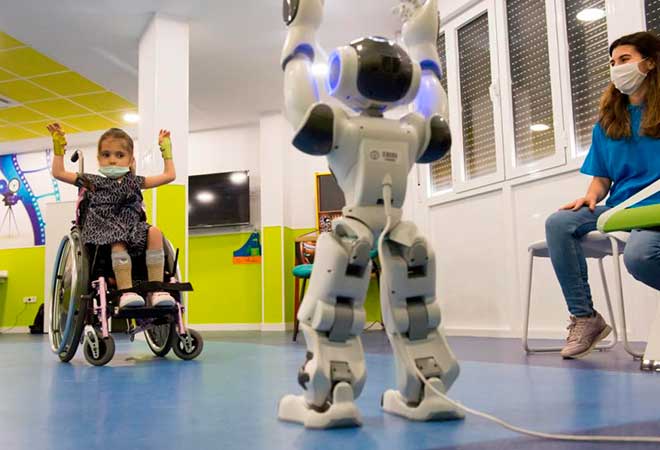They are robots that can communicate and interact with people. They must also be able to build social relationships and adapt to their environment. Social robots are also capable of lifelong learning and integrating new experiences into their interaction with the world or their view of the world. In addition, human interactions should be designed to be as pleasant and easy for humans as possible. Therefore, the robot's behavior should be as realistic as possible so that humans can read it. Except for lifelong learning and accumulated understanding of the world, most requirements have already been met.
However, there is now a great deal of progress in learning. Deep learning is a method that essentially simulates how the brain works and can recognize patterns on its own. Currently, such recognition only works in specific applications, but artificial intelligence can improve on its own.
By the way, a robot that only communicates with other robots is not a social robot. The social element refers only to people and communication with them. Many people are still skeptical about interacting with robots precisely because of how they are portrayed in the media. But even now, with voice assistants, we are also increasingly talking to devices. Social robots are the next step because they can also act proactively.
Tasks
The tasks of social robots are varied. They can be used for training, telepresence, communication, or customer service. They aid learning by providing a fun, various way to practice and learn new skills. Telepresence means they can be a physical proxy for a meeting participant. It is done by using a screen where the participant can be seen. Utilizing a camera, he can see his colleagues or partners on his screen, just like a regular video call. A control function allows the robot to move around the room like a human.
As a companion, the robot primarily provides emotional support. It includes, in particular, the elderly or people with disabilities. Robots do not replace personal care but rather provide additional support. It gives caregivers more time to respond to the needs of their patients better. In customer service, on the other hand, social robots can provide potential customers with information about products and services.
Examples of robots
HitchBOT is a small Canadian robot that was designed to hitchhike. It was transported from one coast to another (2013). Then the same was done in Germany and the Netherlands with a new model (2015). The same model then had to hitchhike across the US. Unfortunately, it was decapitated in Philadelphia. The head was never found. The purpose of the experiment was to learn more about how humans interact with robots and to ask, "Can robots trust humans?" Since the robot could not walk, it had to use communication to convince humans to lift it into a machine and leave it at the end in a place where someone new could pick it up. Despite HitchBOT's decapitation, the inventors concluded that robots could trust humans.
Paro
Paro is also a social robot, though you might not realize it at first glance. It looks like a small seal. The robot from Japan is said to be based on a baby Canadian harp seal. Its big eyes and soft fur make it look quite natural and adorable. The development of Paro began in the early 90s, and he was first introduced to the public in 2001. He is to be used primarily in work with older adults who have dementia, as well as in other situations where animals are difficult to place as support for humans.
The robot is capable of learning; each time it is stroked, it remembers which of its actions resulted in that "reward." He then tries to perform these actions more often to satisfy his owner. How patients interact with Paro can provide caregivers and therapists with information about their state of mind. But there are also criticisms of the robot. Some scientists fear that Paro may replace relationships with real people for some patients.
Kismet
Kismet is the head of a robot developed at the Massachusetts Institute of Technology (MIT) in the 1990s. Dr. Cynthia invented Kismet as an experiment. It was supposed to be able to read and reflect or mimic human emotions. The name Kismet comes from the Turkish language and means fate or luck. To understand people and their feelings, Kismet is equipped with sensors that allow it to hear, see and understand its position in space. It can mimic facial expressions by moving its eyes, eyebrows, eyelids, mouth, jaw, and head.
The robot is specially programmed to understand speech addressed to young children. It can specifically distinguish five different speech types: Approval, Forbidden, Attention, Comfort, and Neutral. The robot can also determine and classify voice pitch and volume. But Kismet can not only imitate and understand facial expressions but also respond. However, its answers resemble baby babble and are challenging to understand.
Tico
Tico is also a social robot. It is designed to help teachers in teaching and at events. Created in 2007 by Treelogic, Tico is now produced by Adele Robots, a five-person company from Spain. It has already been tested in supermarkets and schools and can easily hold a human conversation. Moreover, it has already been tested in schools, and even silent students have become more involved in lessons. Unlike HitchBOT and Kismet, Tico has been available for purchase since 2010. It has sensors and lasers that help it detect obstacles in the room. He also has a camera to scan faces and QR codes.




